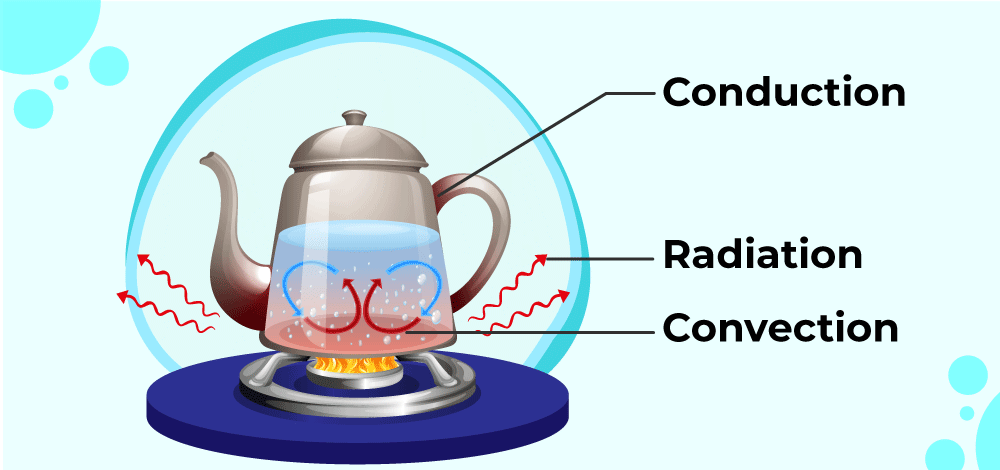
|
|
Convection is one of the ways out of three ways, in which heat can transfer between systems or substances. Other than Convection, Conduction, and Radiation are the other two modes of heat transfer. It has probably been seen that if a cup of hot tea is left on a table for a long period, it cools down. This is due to heat loss to the environment. As a result, heat transfer is described as the transmission of heat or thermal energy from one physical system to another. Therefore, when two bodies have a temperature differential, heat is transported from the hot body to the cooler body. Table of Content What is Convection?The action of heat transmission through movement of major number of molecules inside fluids such as gases and liquids are known as convection. The initial heat transmission between the item and the fluid occurs by conduction, but the bulk of the heat transfer occurs because of fluid motion. Solids do not experience convection because their basic particles do not move. The process of heat diffusion in solids is known as thermal conduction. Under normal conditions, gases and liquids are poor heat conductors, however, they may quickly transport heat by convection. The image added below shows the transfer of heat through convection.
Heat Transfer by Convection: How Does It Work?Convection is the process of heat transfer between a solid and a liquid or fluid that is in contact with the solid. When transmitting heat from one liquid to another through a barrier, convection is essential. Convectional heat transfer occurs either through thermal diffusion (fluid molecule motion) or advection, in which heat is transferred through the bulk motion of heat currents in the fluid. The heat transfer through all three mediums Conduction, Convection, and Radiation is shown in the image below.
Thermal expansion occurs when any fluid is heated from below. The fluid’s density decreases in lower layers as it becomes hotter. The hotter, less dense part of the fluid rises because of buoyancy and is replaced by denser, colder fluid. When this part heats up, it also rises and is replaced by the upper colder layer, and the process is repeated. In this way, convection is used to transmit heat.
Convection ExamplesMelting Ice, raising hot air above the fire, modern air conditioning, car radiators, microwave convection oven, water heater, etc are examples of convection in our daily life. Other than these there are some more examples, which are as follows:
Sea BreezeDuring the day, there is a wind from the sea. Both the water and the land are heated by the sun. Because water has a higher heating capacity than land, it receives more of the sun’s energy yet warms up considerably more slowly. As a result, the temperature above the land rises, heating the air in the surrounding environment. Warm air expands because it is less dense, resulting in a low-pressure region over the land along the shore. Meanwhile, the water is under considerably higher pressure. Due to the pressure differences in the air, the air flows from sea to land. As a result, an unexpected gust of wind is felt known as the sea breeze. The concept of the sea breeze is shown in the image added below.
Land BreezeWhen the situation changes at night, these phenomena arise. The land and sea begin to chill as the sun sets. Due to variations in heat capacity, the land loses heat faster when compared to water. Comparably, the water temperature becomes higher, resulting in low air pressure there. This creates a cool wind off the coast, known as the land breeze. The concept of the land breeze is shown in the image added below.
Type of ConvectionConvection may be divided into two types, which are as follows:
Natural ConvectionWhen the temperature difference occurs, it causes a density difference which produces the buoyant force and convection occurs. This process is termed natural convection. Some examples of natural convection are Oceanic winds, melting of Ice, blood circulation in warm-blooded animals, raising of hot air above the fire, etc. Forced ConvectionForced convection occurs when an external source such as a pump or fan is utilized to produce convection. Utilizing water geysers or heaters for quick water heating, using fans on warm summer days, the engine of automobiles, and man-made suction devices are examples of forced convection. Newton’s Law of CoolingUnder typical circumstances, convection heat transfer is proportional to the temperature differential between the components. This phenomenon has been stated by Newton’s law of cooling, which states:
Newton’s law of cooling is connected to forced convection, which is written as:
Note: The value of h (heat-transfer coefficient) depends on Viscosity, Density, Specific heat capacity, and Thermal conductivity. Read More, Sample Questions on ConvectionQuestion 1: What role does convection play in our daily lives? Answer:
Question 2: Why do not solid materials experience convection? Answer:
Question 3: What are the processes through which convection occurs? Answer:
Question 4: What does “free” or “natural” convection mean? Answer:
Question 5: Natural or induced convection, which has a higher heat transfer coefficient? What is the reason behind this? Answer:
Related article:Convection – FAQsWhat is Conduction, Convection, and Radiation?
What is a Convection Current?
What are the Types of Convection?
Who postulated the Thermal Convection Current Theory?
|
Reffered: https://www.geeksforgeeks.org
| Class 11 |
Type: | Geek |
Category: | Coding |
Sub Category: | Tutorial |
Uploaded by: | Admin |
Views: | 8 |


